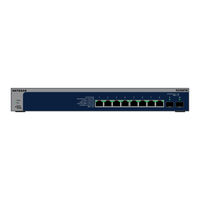NETGEAR XS516TM Manuals
Manuals and User Guides for NETGEAR XS516TM. We have 3 NETGEAR XS516TM manuals available for free PDF download: User Manual, Installation Manual
NETGEAR XS516TM User Manual (661 pages)
8/16/24-Port 10G/Multi-Gigabit Ethernet Smart Switch with 2 or 4 SFP+ Ports
Table of Contents
-
Dashboard48
-
DHCP Server120
-
DHCP Relay129
-
DHCP Snooping139
-
Dhcpv6 Server150
-
Dhcpv6 Relay157
-
About Vlans162
-
Add a VLAN163
-
Change a VLAN166
-
Auto-Vlans174
-
Add an OUI178
-
Remove an OUI179
-
Private Vlans194
-
Protect Ports207
-
Configure a LAG220
-
DAI Acls253
-
Add an MVR Group298
-
Routing Concepts306
-
Ipv4 Routing306
-
Ipv6 Routing311
-
Routing Vlans331
-
Change a Route341
-
Delete a Route342
-
Class of Service353
-
RADIUS Servers386
-
TACACS+ Servers396
-
Storm Control427
-
Port Security431
-
Loop Protection437
-
ACL Wizard447
-
MAC Acls454
-
Add a MAC ACL455
-
Remove a MAC ACL457
-
MAC ACL Rules458
-
MAC ACL Bindings463
-
Ipv4 Acls466
-
Add an Ipv4 ACL467
-
Ipv6 Acls484
-
Add an Ipv6 ACL485
-
Ipv6 ACL Rules488
-
IP ACL Bindings496
-
Logs518
-
Trap Log528
-
Port Mirroring529
Advertisement
NETGEAR XS516TM User Manual (649 pages)
8-Port or 16-Port 10G/Multi-Gigabit Ethernet Smart Switch with 2 SFP+ Ports
Table of Contents
-
-
-
Dashboard51
-
-
-
-
DHCP Server123
-
DHCP Relay131
-
DHCP Snooping141
-
Dhcpv6 Server152
-
Dhcpv6 Relay158
-
-
-
Auto-Vlans175
-
Private Vlans195
-
Protect Ports207
-
-
-
-
Routing Concepts304
-
Ipv4 Routing304
-
Ipv6 Routing309
-
Routing Vlans329
-
-
-
Class of Service350
-
-
-
RADIUS Servers382
-
TACACS+ Servers392
-
-
Storm Control423
-
Port Security427
-
Loop Protection432
-
-
ACL Wizard442
-
MAC Acls449
-
MAC ACL Rules453
-
MAC ACL Bindings458
-
Ipv4 Acls461
-
Ipv6 Acls479
-
Ipv6 ACL Rules482
-
IP ACL Bindings490
-
-
Logs512
-
Port Mirroring523
NETGEAR XS516TM Installation Manual (2 pages)
8-Port 10G/Multi-Gigabit Ethernet Smart Switch with 2 SFP+ Ports, 16-Port 10G/Multi-Gigabit Ethernet Smart Switch with 2 SFP+ Ports
Advertisement


